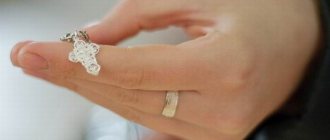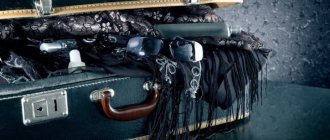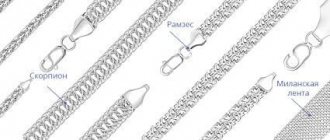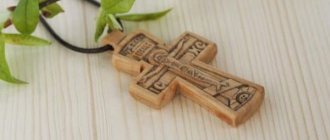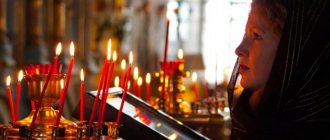The home of not a single Orthodox family is complete without icons; it is a mediator between us and the saints. Prayer in front of an icon is stronger because we have a visual image of the person we are addressing, which helps us concentrate a lot. Icon painting has been known for thousands of years, and during this time a huge number of icons have appeared, but they cannot exist in an unnamed state forever. If the image is badly damaged, we cannot read the face of the saint on it; of course, its owners may want to get rid of the icon. The only rule that needs to be remembered forever is that icons cannot be thrown away like ordinary garbage.
Cross soaked in water
In the sect of cave diggers, the purification of newly joined “sufferers” consisted of a special passage through the labyrinths of underground catacombs. And at every turn of the labyrinth there was a cross. As N. Kanatieva writes in the article “Sectarianism on the Lower Volga Frontier in the 19th Century,” one of the leaders of cave diggers, Andrei Lukyanov, honed the “gift of healing” so much that he performed healing rituals in absentia. He drew a cross on a sheet of paper, sent the sheet to the suffering adepts, and they soaked the sheet with the cross in water and gave the “healing tincture” to the patient.
Information site about icons, prayers, Orthodox traditions.
"Save me, God!". Thank you for visiting our website, before you start studying the information, please subscribe to our Orthodox community on Instagram, Lord, Save and Preserve † – https://www.instagram.com/spasi.gospodi/. The community has more than 49,000 subscribers.
There are many of us like-minded people and we are growing quickly, we post prayers, sayings of saints, prayer requests, and timely post useful information about holidays and Orthodox events. Subscribe. Guardian Angel to you!
The cross is the greatest shrine of the Orthodox. It is a clear sign that a person belongs to Orthodoxy. For the church it does not matter whether it is made of metal or wood, jewelry or an ordinary alloy.
The main thing for an Orthodox should be its form and correctness in relation to religion. It is necessary to remember important points when choosing a cross:
- The cross can be 4-, 6-, 8 final shapes.
- If you choose a cross for your baby, then there should be no sharp corners on it.
- The size, like the material of the cross, does not matter.
- The Church recommends choosing not decorative crosses, but ones with the inscription “Save and Preserve” on the reverse side.
- Crosses purchased in the church are already consecrated, but store-bought ones should be consecrated.
Basically, we receive the attribute at baptism, but it also happens when we lose the cross. What to do? You need to buy a new one and consecrate it. What to do if you find someone else's cross? There are many superstitions about this, saying that if you take someone else’s cross and wear it, then it is the same as if you take on someone else’s cross.
Crosses on shoulder straps
The Fedorovites, who appeared in the Voronezh province in the early 20s of the last century, wore distinctive clothes by which they were recognized. The robe consisted of a white robe or long shirt embroidered with crosses. Instead of a pectoral cross, Fedorovites wore a “necklace of onion heads” around their necks, which personified the bitterness of earthly life. At joint meals of Fedorovites, in which, by the way, hundreds of people took part, they were supposed to eat more onions before the usual dishes. Thus, the adherents demonstrated that grace had left the official Church, therefore all Orthodox Christians should feel their bitter and inconsolable existence. In the Soviet years, Fedorovites wore shoulder straps with crosses on their shoulders.
What to do with an old icon?
Dilapidated, old icons should be taken to the temple. If the image has completely lost its appearance, it will be burned in a church oven. You can burn them yourself, but not together with the garbage, but separately, clean. An icon always remains an icon, no matter what deplorable state it is in. An icon that is slightly faded or has minor damage can also be taken to the church, perhaps one of the parishioners will take it. Not far from the entrance to the temple there is usually a memorial table, where parishioners bring food to honor the memory of the deceased. The icon can be left on the funeral table; it would also be good to bring food, thereby expressing love for your deceased relatives. An unwanted image can be given to a church shop. You should not give someone an icon in poor condition, it will be disrespectful.
Very old icons can be restored, sometimes this turns out to be more profitable from an economic point of view than buying a new one.
After all, an image is often a family heirloom, passed down from generation to generation, and losing it is simply unbearable for family members.
There is no cross on them!
One of the popular religious movements on the territory of the Russian Empire in the 19th century was Stundobaptism. The Stundists borrowed a lot from German Protestant Baptists. They also rejected church sacraments and fasts, did not perform rituals of commemoration of the dead, and did not venerate holy relics and icons. Many Stundists did not perform baptism and did not venerate the cross as a symbol of true faith. The Stundists paid dearly for their views. They were arrested and sent to special camps, their children were forcibly taken away from Stundobaptist parents, rural lynchings were carried out with the Stundobaptists mercilessly beaten and their houses and property burned.
In the “Handbook of Heresies, Sects and Schisms,” edited by S. Bulgakov, the Molokans are also mentioned as those who rejected the pectoral cross. This sect appeared in the 70s of the 18th century through the efforts of the tailor Semyon Uklein. Disillusioned with Doukhoborism, he founded his own circle. Its participants began to be called “Molokans” due to the fact that during Lent, when eating fasting food is prohibited, adherents of the sect drank milk, claiming that they “eat the milk of words.” They rejected church hierarchy, preaching that “all are equal by grace” and openly mocked traditional rituals. Thus, they did not fast at fixed times, but as soon as a person “feels his sinfulness,” while fasting implied a complete abstinence from food and drink. Molokans did not venerate the Mother of God and God's saints, did not venerate the relics of saints and icons, did not use the sign of the cross and did not wear body crosses.
Icons of the former owners of the house
It often happens that when buying a house or apartment, new residents discover abandoned icons. In this case, as in any other, you cannot throw away the icons of the old owners. An icon is a shrine and must be treated with respect. There is nothing wrong with leaving them. But if you are in doubt because of the unknown history of their presence in the house, the icons can be re-consecrated.
In family houses, icons that belonged to deceased relatives are usually kept, which the young people do not want to leave behind. Again, new icons from your home can be taken to the temple or donated if the images have retained their appearance. Many people mistakenly believe that giving and accepting images from someone else’s hands is prohibited, but the church believes that giving them as a gift is a good tradition. The icon cannot harm you, since it is a sacred object. If you doubt its former owners, you can bring it to the temple and ask for it to be consecrated.
Burnt cross
Not only in Russia, but also abroad, there were Christians who refused to wear the traditional body chair. One of the co-authors of the New Chronology, Gleb Nosovsky, described his personal experience of meeting Egyptian Coptic Christians in the summer of 2002. Meeting and communicating with Copts from Cairo, as well as from the Aswan diocese, G. Nosovsky became convinced that they do not forget about the ancient symbol of faith, but do not wear a cross on their neck, but get a tattoo of it on their arm.
In the book “History of Military Monastic Orders of Europe,” V. Akunov writes that not only Egyptian Copts, but also Ethiopians living among Muslims wear a cross tattoo on their wrist. The author believes that this tradition dates back to the times of the Crusades. It was repeatedly mentioned in European chronicles that the crusaders applied the sign of the cross to themselves in the form of a tattoo or brand on their forehead, chest or right hand.
In this, as V. Akunov writes, they imitated the first Christians. They often put a cross on their body, burned out the monogram of Christ, and got a tattoo in the form of a fish, anchor or lamb. Such tattoos were made by Christians living in constant fear of forced rebaptism into another faith. For example, in Serbia captured by the Turks. In addition, a Christian tattoo in the form of a cross simplified identification of the body in the event of death and increased the chances of burial according to Christian laws.
Why do you dream of crosses: dream book
Dreams are the embodiment of a person’s past, present and even future. Seeing the sign of the cross in a dream is not a simple sign, but a warning.
You can find a detailed description of the meanings of the dream book in the table:
| What I dreamed | Meaning |
| Found a cross | You are in danger or someone wishes you harm, but you will be able to avoid the harmful effects |
| An image of a decoration with four, six or eight corners | Higher powers protect from ill-wishers. Perhaps in life you will have a real protector |
| Find your own vest | Don’t despair, don’t look at the many obstacles, but keep moving towards your goal |
| Find a married lady | Family troubles and children's illnesses |
| Find chain | Evil does not sleep and will try to lead you astray |
| Golden vest | Look forward to joyful events |
| From a different material | Expect challenges that will bring relief |
| Find someone else's cross | Someone around you wishes harm to your family |
Important! The church does not support the interpretation of the dream book. These meanings come from astrology.
Cross on the heel
In the book “God of War,” G. Nosovsky quotes a description of the ritual that was performed on newborn Mamelukes, based on Martin Baumgarten’s monograph “Journey to Egypt, Arabia, Palestine and Syria.” This book, first published in Nuremberg in 1594, was only translated into Russian in 1794 and published in St. Petersburg by the Printing House of Foreign Fellow Believers. The German noble traveler Martin Baumgarten describes 16th-century Egypt in it, in particular mentioning that the ranks of the Mamelukes were replenished from Christian fugitives - Albanians, Italians, Serbs, Spaniards, Germans.
No one, according to Baumgarten, could become a true Mameluke without avoiding a kind of baptism. During the ritual, it was required to renounce the old faith and voluntarily undergo circumcision. The action ended with the ritual burning of a cross on the heel, which consolidated the rejection of Christianity and symbolized the literal violation of faith, disregard for Christian laws and the right to flagrantly violate them.
What should you do if you find someone else's cross?
On the one hand, signs do not advise picking up a found cross, especially if it was found at an intersection. It is better to leave such a thing where it was. However, the clergy say that it is not good for the shrine to lie in the dust.
If you sincerely believe in omens and are afraid of getting into trouble, before picking up this object you should cross it and read a short prayer.
Church workers are confident that the found cross is a symbol of the manifestation of God's mercy. And if you leave the amulet on the road, you will thereby desecrate it.
Then you can do the following:
- Hang it on the branch of a nearby tree - perhaps the person who has lost the amulet will return to find it.
- If you are a deeply religious person, you should take the amulet you find to church and donate it to some icon. According to superstitions, only a good person is destined to find a cross by chance. The sign says that a sinner will never discover a shrine under his feet.
Is it possible to wear a found cross?
Signs do not advise wearing a found cross. Superstitious people claim that you cannot wear such a find on yourself, otherwise you will have to shoulder the sins of others.
However, there is an exception to this rule. The priests say that unbaptized people who are just planning to convert to Christianity can keep the find. And here it is very important that the decision of the person who finds the cross is influenced not by a sign, but by a sincere desire.
As you can see, opinions about the found cross vary greatly, and the interpretation of the sign can have both positive and negative meaning. However, remember that you should always set yourself up only for the good. If you find a cross, act like an Orthodox person and take it to the temple.
